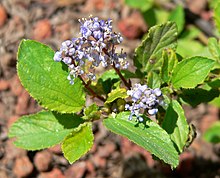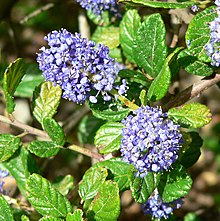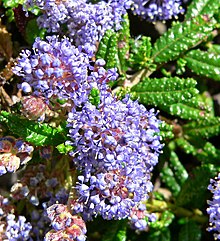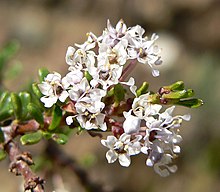Sacred flowers
| Sacred flowers | ||||||||||||
|---|---|---|---|---|---|---|---|---|---|---|---|---|

Ceanothus hybrid as an ornamental plant |
||||||||||||
| Systematics | ||||||||||||
|
||||||||||||
| Scientific name | ||||||||||||
| Ceanothus | ||||||||||||
| L. |

The ceanothus ( Ceanothus ) are a plant genus of the family of the cross thorn plants (Rhamnaceae). In German, some species are sometimes also - botanically incorrect - referred to as "Californian lilac", as the blue panicles of the plants, which mainly come from the American west coast, are reminiscent of lilac blossoms.
description
Ceanothus species grow as shrubs , more rarely as small trees . They reach heights of growth between a few centimeters and 3 meters, only the two Californian species Ceanothus arboreus and Ceanothus thyrsiflorus can grow significantly higher. Many Ceanothus species form low, bushy cushions, so they are significantly wider than they are tall. The majority of the Ceanothus species are evergreen , but there are also some deciduous species that live in areas with colder winters.
The leaves can be opposite or alternate depending on the species . Most species have rather small, 1 to 5 centimeters long, undivided, oval leaves. Depending on the species, the leaf margin is more or less entire, notched to serrated. In many species the leaf veins are clearly sunk.
Many three-flowered, zymous partial inflorescences stand together in terminal or lateral paniculate or trugdoldigen total inflorescences . The flowers are less than 5 millimeters long and five-fold with a double flower envelope . They have five lanceolate to triangular sepals that are colored similar to the five petals . The colors of the petals range from blue to purple, in some species from white to pink.
Dry or fleshy, triple capsule fruits are formed.
ecology
The saccharose species enter into a symbiosis in the root area with nitrogen-fixing actinomycetes from the genus Frankia , the so-called actinorrhiza . In their habitats in the dry mountain forests of the American Pacific coast , they are the most important nitrogen-fixing plants.
Occurrence
The genus Ceanothus occurs exclusively in North to Central America, with the majority of the species being native to California . Only a few species, for example Ceanothus americanus , are also found in the eastern United States and southern Canada . Others, however, such as Ceanothus coeruleus , also occur south of California to Guatemala .
Almost all species grow on rocks or in dry forests on stony or sandy soil, also near the coast. They can withstand drought and salt. In contrast, soil moisture or wetness shortens their lifespan. Most species also cannot tolerate shade.

species
The genus Ceanothus contains 50 to 60 species (selection):
- American sackling ( Ceanothus americanus L. ): It is native to eastern North America from Canada to Florida.
- Ceanothus arboreus Greene : This 1 to 9 meter high tree comes from the southern California islands.
- Ceanothus coeruleus Lag .: The home ranges from Mexico to Guatemala .
- Ceanothus confusus J.T. Howell
- Ceanothus connivens Greene
- Ceanothus cordulatus Kellogg : It occurs in Oregon, California, New Mexico and in the Mexican state of Baja Norte .
- Ceanothus crassifolius Torr. : It occurs in California and the Mexican state of Baja Norte .
- Ceanothus cuneatus (Hook.) Nutt. : It occurs in Oregon, California and the Mexican state of Baja Norte .
- Ceanothus cyaneus Eastw. : It occurs in California.
- Toothed sackflower ( Ceanothus dentatus Torr. & A. Gray ): It is found in California.
- Sankt-Helens-Säckelblume ( Ceanothus divergens (Brandegee) Parry )
- Ceanothus diversifolius Kellogg
- Fendler's sacrum ( Ceanothus fendleri A.Gray ): Their home is the USA and northern Mexico; it is used in culture as a ground cover .
- Ceanothus ferrisiae McMinn : It occurs in California.
- Ceanothus foliosus Parry : It occurs in California.
- Ceanothus fresnensis Dudley ex Abrams
- Ceanothus gloriosus J.T. Howell ; Home: California
- Ceanothus greggii A. Gray : It occurs in Arizona, Nevada, Utah, New Mexico, California, Texas and Mexico.
- Ceanothus griseus (Trel.) McMinn ; Home: California
- Ceanothus hearstiorum Hoover & Roof
- Ceanothus herbaceus Raf. : It occurs in Canada and the United States.
- Saint Barbaras sack flower ( Ceanothus impressus Trel. ); Home: California; this small-leaved, evergreen species is offered as an ornamental plant.
- Ceanothus incanus Torr. & A. Gray : It occurs in California.
- Ceanothus insularis Eastw.
- Ceanothus integerrimus Hook. & Arn. : It occurs in California.
- Ceanothus jepsonii Greene : It occurs in California.
- Ceanothus lemmonii Parry : It occurs in California.
- Ceanothus leucodermis Greene : It occurs in California and in the Mexican state of Baja California .
- Ceanothus maritimus Hoover
- Ceanothus martini M.E. Jones : It's found in Arizona, Nevada, Utah, Wyoming, and Colorado.
- Ceanothus masonii McMinn
- Ceanothus megacarpus Nutt. : It occurs in California.
- Ceanothus oliganthus Nutt. : It occurs in California.
- Ceanothus ophiochilus S.D. Boyd et al. : It occurs in California.
- Ceanothus palmeri Trel.
- Ceanothus papillosus Torr. & A. Gray ; Home: California
- Ceanothus parryi Trel.
- Ceanothus parvifolius (S. Watson) Trel.
- Ceanothus pinetorum Coville
- Ceanothus prostratus Benth. : This mountain plant, which is only a few centimeters high but grows up to 3 meters in width, comes from the west coast of the USA, from Washington Stateto California .
- Ceanothus pumilus Greene
- Ceanothus purpureus Jeps. ; Home: California
- Ceanothus roderickii W. Knight : It occurs in California.
- Ceanothus sanguineus Pursh : It occurs in British Columbia , Washington, Oregon, Idaho, Montanan and California.
- Ceanothus serpyllifolius Nutt.
- Ceanothus sonomensis J.T. Howell
- Ceanothus sorediatus Hook. & Arn. : It occurs in California.
- Ceanothus spinosus Nutt.
- Ceanothus thyrsiflorus Eschsch. : This 1 to 6 meter high tree thrives in the humid coastal forests of California.
- Ceanothus tomentosus Parry
- Ceanothus velutinus Douglas : It has attractive, glossy leaves. It occurs in Alberta, British Columbia, South Dakota, Washington, Oregon, Idaho, Montana, Wyoming, Colorado, Nevada, Utah, and California.
- Ceanothus verrucosus Nutt. : It occurs in California and the Mexican state of Baja Norte .
A species rank hybrid is:
- French hybrid sackling ( Ceanothus × delileanus Spach ): It is a French cross between Ceanothus americanus and Ceanothus coeruleus . The compact, deciduous shrub is considered very hardy. The 'Gloire de Versailles' variety is particularly well known.
use
Because of their light blue, often abundantly formed inflorescences, sacred flowers, especially hybrids , are used as ornamental plants .
Many hybrids are used as ornamental plants , including:
- Ceanothus 'Blue Mound' is a horticultural hybrid (from Ceanothus thyrsiflorus ?) With purple to blue colored flowers. It becomes about 250 cm high and remains very compact. Suitable for a sheltered location where the strong, evergreen leaves come into their own. Established plants bloom spectacularly with bright blue flowers.
- Ceanothus impressus 'Victoria' is the most robust of the evergreen sack flowers, with strong green leaves and deep blue flowers in early summer, which thanks to the evergreen dainty foliage retains its ornamental structure even in winter.
Sources and further information
literature
- Gordon Cheers (Ed.): Botanica . Random House Australia 2003. German edition: Tandem Verlag GmbH 2003, ISBN 3-8331-1600-5 .
- D. Moerman: Native American Ethnobotany . Timber Press, Oregon 1988.
- Walter Erhardt among others: The big pikeperch. Encyclopedia of Plant Names . Volume 2. Verlag Eugen Ulmer, Stuttgart 2008. ISBN 978-3-8001-5406-7
Individual evidence
- ↑ NJ Ritchie, DD Myrold: Geographic distribution and genetic diversity of Ceanothus-infective Frankia strains . In: Appl Environ Microbiol . tape 65 , 1999, pp. 1378-1383 .
- ^ Robert Zander : Zander. Concise dictionary of plant names. Edited by Walter Erhardt , Erich Götz, Nils Bödeker, Siegmund Seybold . 17th edition. Eugen Ulmer, Stuttgart 2002, ISBN 3-8001-3573-6 .
- ↑ a b c d e f g h i j k l m n o p q r s t u v w Ceanothus in the Germplasm Resources Information Network (GRIN), USDA , ARS , National Genetic Resources Program. National Germplasm Resources Laboratory, Beltsville, Maryland. Retrieved April 30, 2017.
Web links
- Cliff Schmidt's Ceanothus Descriptions
- Susan G. Conard, Annabelle E. Jaramillo, Kermit Cromack, Jr. & Sharon Rose: The Role of the Genus Ceanothusin Western Forest Ecosystems - Report of a workshop , Oregon State University, Corvallis, Oregon, 1982 (PDF; 948 kB)
- Ceanothus species - Utah State University ( Memento from October 14, 2005 in the Internet Archive )
- University of Wisconsin Stevens Point Plant Database : Ceanothus americanus
- Ceanothus integerrimus at Plants For A Future
- Fire Effects Information : Ceanothus integerrimus ( Memento from September 9, 1999 in the Internet Archive )








